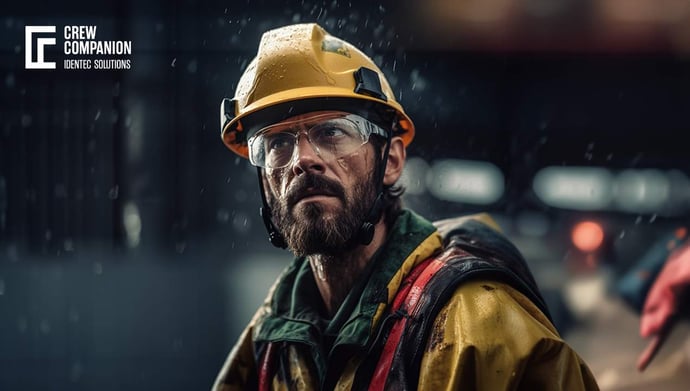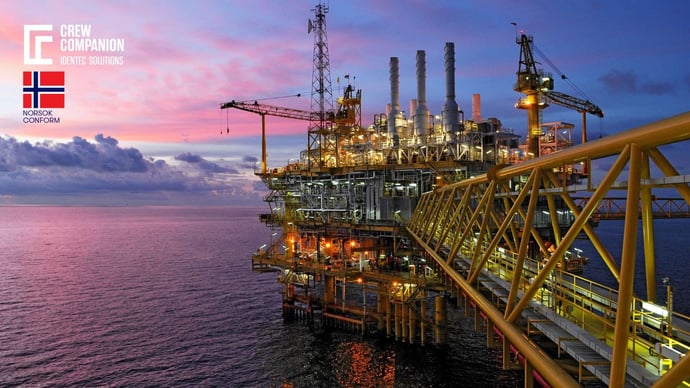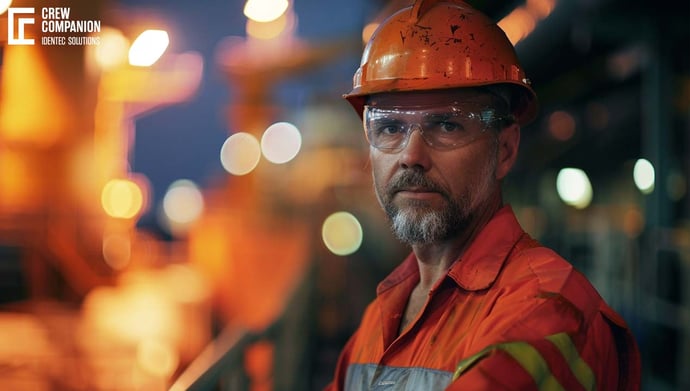Electronic Mustering on Drill Ships (FPSO): How to Run Mustering Drills
| Written by Michal Wozniakowski-Zehenter

No video selected
Select a video type in the sidebar.
How Important are Mustering Drills?
Before diving into the process, it's essential to understand the significance of mustering drills and three parts of it - Safety First (really), Regulatory Compliance and identifying weaknesses:
These drills do more than just show escape routes. They help everyone on board feel safe and ready. By practising, sailors know where to go and what to do during emergencies. This can save lives in real crises. Imagine a time when things go wrong on a ship. Confusion can make things dangerous. However, because of their training, the sailors can act calmly and organized. They know where to go and what to do. This shows how important and effective these drills are. But it's not just about following steps. These drills bring the crew together. By facing fake dangers together, they build trust and teamwork. So, when real challenges come, they can rely on each other. These drills teach them to work together and face any storm as a united team (read more about EHS risk assessment).
Instead of just regular drills, these practices clarify the intricate guidelines of emergency actions for seafarers - whether it's handling fires, preventing crashes, or managing dangerous leaks. Through consistent practice of these manoeuvres, ocean experts reconfirm their commitment: each seafarer stays prepared, with rapid response instincts honed, even in the unpredictable moods of the ocean. Yet, it goes beyond mere human capability. Assembly drills serve as keen lenses, examining the core integrity of safety equipment and rapid reaction systems on board. This reflective journey allows ocean experts to identify vulnerabilities, prompting immediate reinforcements.
Consequently, the safety scope continuously progresses, aligning with the highest standards of maritime watchfulness. More than just fulfilling rules, these drills sing praises of deep-seated dedication to the seafarer, the vessel, and the boundless marine realm. They tell tales of steadfast commitment to an ethos where safety is both taught and practised. This philosophy, resonating beyond metal and masts, spreads throughout the maritime domain, emphasizing a sector-wide agreement: Before profit and pursuits, safety takes precedence. These drills also help find gaps in the emergency plans and improve them (read also more about the emergency response kit for FPSOs).
Incorporating Feedback and Continuous Improvement
The journey to optimum electronic mustering on FPSOs and drillships does not stop at new technology implementation but continuous refinement and improvement. Continuous feedback loops are important in the enhancement of the effectiveness of mustering procedures. After each drill, a debriefing session should be conducted where each crew would air their experiences and insights. This open dialogue helps reveal the blind spots and holes that need improvement, thus building a culture in which feedback is treated like a commodity, and every voice counts in enhancing safety. Some of those suggestions emanating from crew members range from refining the positioning of RFID readers to improvements in the clarity of signage related to the location of muster points. Thirdly, reviewing drill performance data may point out any trends or recurring issues that may require attention. Data-driven insights such as these place the leadership in a better position to make informed decisions on protocol changes or investments in more sophisticated technologies. Regular training in different scenarios, using both electronic and traditional methods, maintains the crew's versatility and adaptability at a high level for whatever can happen. The human factor is more than equipment and technology; building a safety culture based on vigilance and readiness will be paramount. It is, therefore, important that the strategies and tools used in electronic mustering continue to change with the times, reflecting best practices and embracing new technologies. In adopting an attitude of continuous improvement, FPSOs and drillships will be able to not only meet but also set new standards for safety at sea.
ADDING THE TECHNOLOGY THAT EASES YOUR LIFE
Embarking upon the realm of electronic mustering, you definitely stumble across the merger of maritime safety with cutting-edge technologies like Radio Frequency Identification (RFID). This innovation automates the counting of crew members at muster points, expediting the headcount process and minimizing traditional manual trials. Such advancements elevate efficiency and free up precious moments for other pivotal emergency tasks. An effective voyage into electronic mustering drills demands detailed planning. Though spontaneous drills test the ship's mettle, notifying crew members about impending drills paves the way for a mental readiness that yields authentic outcomes. Prior to setting sail on such drills, it's of paramount importance to verify the operational status of tools in the electronic mustering arsenal, be it handheld scanners or anchored RFID devices. The call to action resonates with the activation of the ship's emergency alarms. Alarms' cadence might vary, echoing the nature of the drill, from fiery blazes to overboard emergencies. As the alarms toll, the drill unfurls, beckoning crew members to their preordained muster sanctuaries.
In the throes of the drill, as crew members converge at muster zones, the marvel of RFID technology seamlessly logs their presence. Discrepancies, if they emerge, must be earmarked for introspection. The muster captains remain in constant dialogue with the ship's helm, offering real-time insights into the muster scene. Upon reaching the drill's culmination, either with a full crew muster or as the set time elapses, it's pivotal to convene a reflective assembly. Post-drill musings, where each sailor's voice resonates, cultivate an ethos of perpetual refinement, bolstering the ship's state of readiness. In the chronicles of electronic mustering, documentation stands as a stalwart beacon. Chronicle each drill with its timestamps, course, and any notable milestones or hurdles. This diligent record-keeping not only anchors regulatory compliance but weaves a tapestry of lessons for ensuing endeavours.
Periodic audits and technological upgrades to the electronic mustering system are indispensable to keeping the ship steady on the course of maritime safety. Sift through the digital sands to discern the rhythm of each drill. Do certain muster points lag behind in the electronic embrace? Identifying and navigating these turbulent waters is essential. With technology's relentless march, updating the electronic mustering compass ensures the ship remains attuned to the latest technological horizons.

What are the Benefits of Electronic MUSTERING?
As technology improves, the old method of using paper and pen to count crew is being replaced by faster electronic methods. Thanks to tools like RFID tags and other digital helpers, counting crew has become quicker and easier, bringing benefits we could only imagine before.
A big plus of this new way is its speed. When emergencies happen, time is very important. Every second counts. Using electronic systems to count makes it fast and sure. This quick method saves time and adds an extra layer of safety, ensuring every crew member is checked.
Another benefit is accuracy. People can make mistakes, especially in stressful situations. But with RFID tags for each crew member, wrong counts are almost a thing of the past. This makes the counting process more reliable and less chaotic.
Finally, electronic counting gives real-time updates. This means that as things change, the information updates instantly. Knowing where each crew member is at any moment helps those in charge make the best decisions quickly. This helps keep everyone safe during emergencies (learn more about offshore safety equipment)
CONSTANT UPGRADE
Using the experience from past drills and real emergency situations improves training methods and by keeping up with the latest safety rules, it helps the crew be ready for unexpected challenges. Making sure that the basis of the training on current industry standards and smart strategies means that sailors get effective training (using e-mustering at its best).
Staying updated is essential, especially nowadays, when technology evolves almost overnight. Checking and improving electronic counting systems regularly can offer new possibilities and make things work better. Using the latest tech tools, whether they're for better communication or for data analysis, improves emergency handling. In the world of sailing, being successful means always adapting and being quick to change. By updating the training methods and using the newest tech tools, the sailors are trained and ready for anything the sea throws at them.
FAQS
What is the purpose of FPSO?
Equipped with cutting-edge systems and equipment, it can process and treat crude oil directly from offshore wells. Being a floating structure, it can easily be relocated to different oil fields, allowing for optimal resource utilization. Once the oil has been processed and stored on the FPSO vessel, it is transferred to tankers for transportation to refineries. These tankers, also known as shuttle tankers, are specifically designed to load oil from the FPSO safely and efficiently.
What is a drillship?
A drillship is a maritime vessel equipped with a drilling apparatus. It is often built on a modified tanker hull and equipped with a dynamic positioning system to maintain its position over the well.
TAKEAWAY
Sailing the rigorous tides of FPSOs and drillships, where each sailor's sanctuary stands at the helm, the call isn't merely a moral compass but a code etched in maritime law to shield their souls. The emergence of electronic mustering isn't just a nod to tech's embrace; it's akin to charting unexplored waters, ensuring that when the storm bell tolls, every sailor's presence echoes with clarity. Maritime captains can amplify their guardian vows during crises and shrink the shadows of unforeseen tempests by hoisting this beacon of innovation.
As we anchor this narrative, the voyage with electronic mustering charts an enlightened course in the demanding seascape of FPSOs and drillships. Through periodic drills, vigilant compass checks, and the embrace of tech's new dawns, enterprises can sculpt sailors not just ready to brave storms but skilled to dance with them. With this reimagined compass in hand, the maritime odyssey pledges to cradle its kin, crafting a legacy of unyielding safety and sanctuary amidst the waves.
Dive deeper into one of our core topics: Emergency Response Management
Glossary
Regulatory compliance in offshore - is to the adherence to laws, regulations, and industry standards governing offshore oil and gas operations. It ensures safety, environmental protection, and operational integrity in offshore activities. Compliance involves following guidelines set by regulatory bodies such as the International Maritime Organization (IMO), the Occupational Safety and Health Administration (OSHA), and local authorities. Key areas include worker safety, pollution prevention, structural integrity, and emergency response preparedness. Companies must conduct regular inspections, risk assessments, and audits to meet regulatory requirements. Non-compliance can result in legal penalties, environmental damage, and operational shutdowns, making strict adherence essential for offshore operations. (2)
Sources:
(1) https://assets.publishing.service.gov.uk/media/6362426ae90e0705ad93ee3b/MSIS27.11_R10.22.pdf
https://marine-offshore.bureauveritas.com/offshore/categories/offshore-compliance
Note: This article has been updated on the 6th of March 2025

Author
Michal Wozniakowski-Zehenter, Marketing Manager
Michal Wozniakowski-Zehenter is an experienced marketing and project management professional. He spent most of his career on projects with a strong focus on digital marketing and event management. He is a very active voice representing offshore and mining industries through social media channels. Michal writes mainly about offshore oil and gas, renewable energy, mining and tunnelling. Compiling and sharing the knowledge within industries is one of his goals.
Related Articles
Related Product





